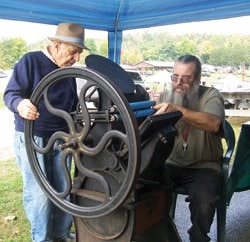Jim Montague is the executive editor for Control. Email him at [email protected].
The best way to learn any new activity is to get your hands on it. That's why yesterday's engineers often talk about their Erector sets, and tomorrow's engineers are diaper-deep in Duplos (Legos for babies). Sure, eyesight and hearing are terrific, but you know you're in a really immersive situation when touch, smell and taste get involved too. That's where the deep impressions, memories and lifelong fascinations have a chance to sprout and take root.
For example, one of the times I accompanied my dad, Richard Montague, to his reporting and later editing jobs at the New York Post in the 1960s, I got to visit the composing floor. It had dozens, if not hundreds, of Linotype machines, all clattering at the same time to produce lead/tin-alloy slugs from lines of brass type for the newspaper's daily editions. The noise was close to deafening, and the whole place smelled of ink and lubricating oil. Personally, I was impressed by the pots of molten metal on each machine. Super cool.
SEE ALSO: Let's Help Schools Teach Machinists
I was in a slightly quieter, but equally colorful setting a few weeks ago, when I visited my dad and a 1953 Mergenthaler Linotype in the print shop at the Hudson Valley Old-Time Power Assn. (HVOTPA) in Claverack, N.Y. The 38-year-old club's members collect, restore, maintain, operate and exhibit antique engines, tractors, farm implements, printing equipment and rare tools. Their mission is, "to preserve the past for the future." I helped out with the printing presses, wooden and metal type, Linotype and other equipment that my dad and two friends, G. Willard Doyle and John Rieker, operated at the club's print shop during HVOTPA's annual Old-Time Days event on Oct. 5-6. Several hundred visitors took in demonstrations of the club's equipment, including an immense 100-hp Ingersoll-Rand diesel motor and compressor, which reportedly powered tools during construction of New York City's Holland Tunnel in 1920-27 and provided its workers with fresh air.
Printers G. Willard Doyle and John Rieker fit new rollers onto a 1901 Golding "Pearl" printing press during Old-Time Days, Oct. 5-6, at the Hudson Valley Old-Time Power Assn. (HVOTPA).
Similarly, the print shop's Linotype is driven by a 220-V, 1.5-A, three-phase Emerson motor that runs at 860 rpm and turns a camshaft with about 14 different cams, which retrieve the brass letters in four different point sizes in response to keystrokes, complete the casting process for each line, and even resort the letters back into a large enclosed magazine when each casting is finished. The shop also operates a 220-Vac, 12-A, 80-cycle Ludlow headlining machine with Cutler-Hammer heater controls, which produces larger-type headline slugs from handset dies. It also has several manual presses, including a 1901 Golding "Pearl" printing press, which can print the shop's many varieties and sizes of type.
"We're just happy to show how all the old 19th and 20th century printing techniques work, and show how publishing with our wonderful wood and metal type is connected with reading, literacy and education," says Montague. "In fact, the art of printing from raised surfaces is still flourishing in many part of the U.S."
During the event, several dozen young visitors engaged all their senses as they played with the letters, assembled the frames or "chases" that hold them together, and manually printed their names using personalized slugs in large type. The shop provides a vivid example of how handset type was revolutionized by automatic typesetting in the early 1900s, and links the invention of printing centuries earlier with today's emergence of computers, digital printing and the Internet. Once again, this level of hands-on experience and historical context can benefit science, technology, engineering and math (STEM) programs in every manufacturing field, help spark interest in the potential engineers we'll need soon, and ensure our collective future with help from a well-preserved past and the lessons it teaches.
For more on HVOTPA and its large motors and generators, read the Control Report column in the November issue of Control at "Old-Time Motors Provide Reminders of Reality."







